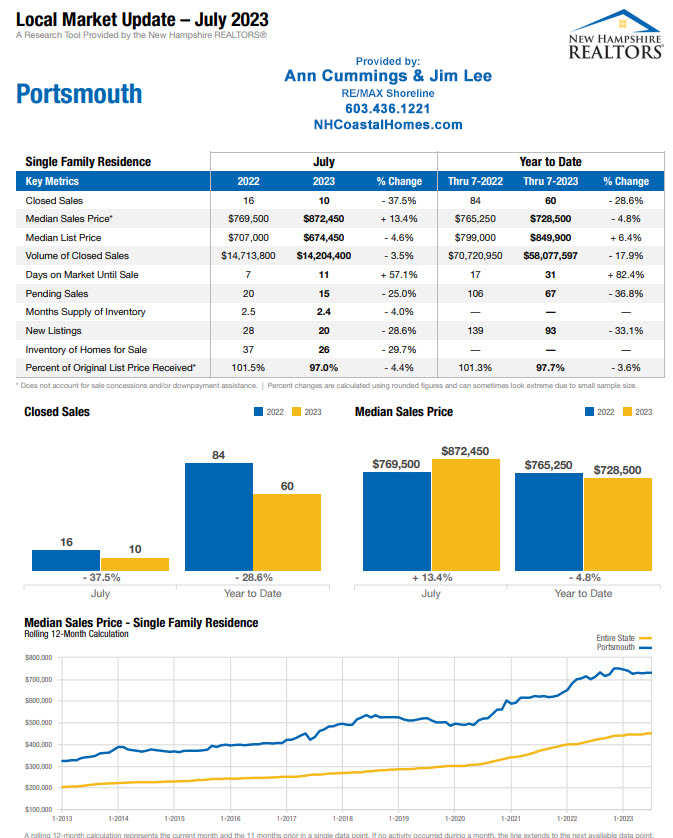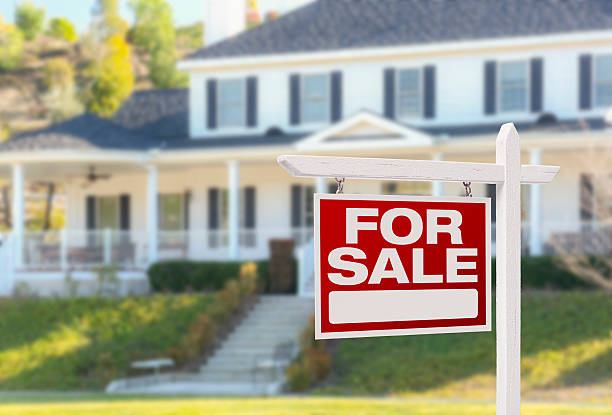How Long Will it Last?
Purchasers of homes in Portsmouth continued to face high prices and limited choices during the month of July. As the accompanying chart shows, the median sales price increased 13.4% to $872,450 in 2023 compared to $769,500 the previous year.
The good news is that the year-to-date median sales price declined by almost 5% to $728,500.
The average sales price in July 2023 was $1,420,440 for the 10 closed sales.
But this can be misleading. Recall that the average is calculated by adding the purchase price of all the homes sold in that period and dividing the total by the number of homes sold. It can be skewed by a single transaction and July provided a perfect example. The estate on Martine Cottage Way was purchased for a whopping $6,600,000 while the small ranch on Spinney Road closed for $445,000.
In 2004, the average single family home sales price in Portsmouth was $300,083.
Then in 2008, the housing bubble burst and the average sales price dropped as low as $250,500. It quickly jumped back over $300,000 in March of 2009 and hasn’t been below it since then.
The problem today: lack of inventory
As the chart points out, so far this year, the number of closed sales has dropped 29% compared to a year ago.

Why are so many current homeowners reluctant to sell? Look no further than the Federal Reserve Bank’s actions.
Since March 2022, the Federal Reserve has hiked its policy interest rate (federal funds rate) at a breathtaking pace. This belated effort to tame inflation that had soared to a 40-year high has had a cascading impact on all debt-related areas of our economy including the residential real estate market.
According to Freddie Mac, at the end of this year’s second quarter, the spread between the effective interest rate on outstanding mortgages and the rate on new mortgages – 3.6% versus 6.5% – was at an historic high. Since then, it has gotten even wider. According to Bankrate, today the interest rate on a fixed 30-year conventional mortgage is 7.53%
Some call these golden handcuff mortgages.
There’s an interesting story going around that the rising interest rates have lowered the divorce rate. It seems keeping your current 3% interest rate mortgage is more desirable than divorcing your spouse. Not sure if there’s any truth to this or not, but it does make a good story.
What we hear from local sellers is that some would like to sell and, of course, they could get a big premium over what they paid a few years ago. But then they would become buyers and join those today chasing too few homes for sale.
It’s hard to call this a housing bubble.
The housing bubble that burst 15 years ago was largely driven by lenders making too many sub-prime loans to people that were not even marginally qualified by today’s lending standards and had little hope or chance of ever repaying their loans. Now lenders have tightened their standards considerably and today’s borrowers are well-qualified for the loans they are able to get. As a result, the number of foreclosures has been much lower so far.
The bottom line: We’re in a low inventory crisis driven by sellers unwilling to give up desirable, low interest loans.
According to the National Association of Realtors, 1.1 million existing homes were listed in July 2023 compared to 1.9 million in July 2019. Additionally, the supply of new homes is still not meeting the demand.
Mortgage rates will remain high relative to the past few years and are not expected to edge downward until the Federal Reserve is convinced that their 2% inflation target can be met.
Housing prices in Portsmouth and the New Hampshire Seacoast will continue to rise but the rate of increase will slow through the remainder of 2023 and into 2024.
Note that the lower section of the chart demonstrates that the increase in median home prices has been a state-wide phenomenon. In fact, it has been happening all across the country.
These market dynamics show why the current Portsmouth City Council’s efforts to shovel taxpayer money into affordable housing and workforce housing is akin to charging windmills.
The unaffordable housing of today is caused by bad government policies of a few years ago. It’s just throwing good money after bad and will lead to future market distortions.
Source of featured image: Stockphoto.com











